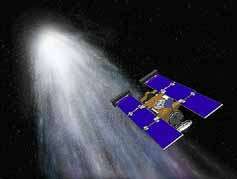March 8, 2010 report
Stardust spacecraft may have found cosmic dust

(PhysOrg.com) -- The first specks of interstellar dust may have been found by NASA's Stardust spacecraft during its seven-year-long voyage. Interstellar dust is believed to form from gas ejected from stars, which condenses to form tiny specks or grains. These then flow through space and contain the heavy atoms that are thought to form the building blocks of stars and planets.
Stardust was launched on its 4.8 billion kilometer mission with the primary goal of collecting dust from the comet Wild 2 in 2004, and returning it to Earth for scientific analysis, but its secondary goal was to collect particles of the interstellar dust stream passing through our Solar System. To collect the dust, the spacecraft had a Stardust Interstellar Dust Collector (SIDC), which was basically a retractable arm with cells filled with a porous substance called aerogel, designed to trap dust particles.
The spacecraft and its samples of dust returned to Earth early in 2006, and scientists investigating the samples have now reported two different kinds of dust grains among the samples, which may be interstellar dust. The team involved members of the public in investigating the aerogel collection, using an Internet application called Stardust@ Home, which allows interested people to use a virtual microscope to the millions of images.
The first particle was found by Bruce Hudson of Ontario, Canada, and is known as particle 30. He called the particle Orion. The scientists then found the second grain, which Hudson named Sirius, and have identified in all 28 impact ‘tracks’ in the aerogel collector. Most of the tracks were at angles that suggested they were particles of debris from collisions with the solar panels on the spacecraft, but seven had ambiguous trajectories, with particle 30 among these.
Hudson had suffered a stroke in 2003, and thought the Stardust@Home project would be a productive way of using his time. He spent up to 15 hours each day for a year scanning pictures, taking five seconds per slide. He was one of around 27,000 volunteers who checked the 71 million images of material captured in the Stardust collection cells.
Leader of the team, Dr Andrew Westphal, of the University of California at Berkeley, announced the findings during a Lunar and Planetary Science Conference (LPSC) in Texas. He said two particles hit the aerogel together, and were two components of the same particle, but were very different from each other. Dr Westphal said if the particles do turn out to be interstellar dust, it is more heterogeneous than previously thought.
Westphal said the findings are preliminary and could be a false alarm. The analyses on the particles are being done with great care to avoid damaging the particles, which he said would take $300 million to replace. He said the material was fine-grained and has an elemental composition consistent with that expected for interstellar dust, although it contains other elements which are surprising but not inconsistent. Elements found in the dust so far include magnesium, iron, aluminum, nickel, copper, manganese, chromium and gallium.
The results are published in the journal American Mineralogist. In January 2006, the spacecraft Stardust returned its sample capsule to Earth, but it remains in space and is currently nearly half-way through a journey to reach the comet Tempel 1.
© 2010 PhysOrg.com

















